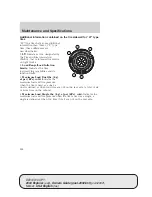
Never spin the tires in excess of the 35 mph (55 km/h) point
indicated on the speedometer.
Highway hazards
No matter how carefully you drive there’s always the possibility that you
may eventually have a flat tire on the highway. Drive slowly to the
closest safe area out of traffic. This may further damage the flat tire, but
your safety is more important.
If you feel a sudden vibration or ride disturbance while driving, or you
suspect your tire or vehicle has been damaged, immediately reduce your
speed. Drive with caution until you can safely pull off the road. Stop and
inspect the tires for damage. If a tire is under-inflated or damaged,
deflate it, remove wheel and replace it with your spare tire and wheel. If
you cannot detect a cause, have the vehicle towed to the nearest repair
facility or tire dealer to have the vehicle inspected.
Tire pressure monitoring system (TPMS)(if equipped)
When the tire pressure monitoring
system warning light is lit, one or
more of your tires is significantly
under-inflated. You should stop and
check your tires as soon as possible,
and inflate them to the proper pressure as indicated on the vehicle’s tire
information placard (label). Driving on a significantly under-inflated tire
causes the tire to overheat and can lead to tire failure. Under-inflation
also reduces fuel efficiency and tire tread life, and may affect the
vehicle’s handling and stopping ability. Even if your vehicle is equipped
with a tire pressure monitoring system, it is still important that you
manually check the inflation pressure of your tires regularly. Each tire,
including the spare, should be checked monthly when cold and set to the
recommended inflation pressure as specified on the vehicle placard
(label) and in the owner’s manual.
Note:
The Tire Pressure Monitoring System (TPMS) monitors tire
pressure in each pneumatic tire. The pressure in each tire is dependent
upon several factors, one of them being the contained air temperature
(temperature of the air inside the tire). As the contained air temperature
increases, the tire pressure also increases. While driving in a normal
manner, a typical passenger tire inflation pressure may increase
approximately 2 to 4 psi (14 to 28 kPa) from a cold start situation. This
increase in tire pressure is due to an increase in the contained air
REVIEW COPY:
2004 Explorer
(exp)
, Owners Guide (post-2002-fmt)
(own2002)
,
Market:
USA English
(fus)
Maintenance and Specifications
259
Содержание 2004 Mountaineer
Страница 280: ...280 ...
















































